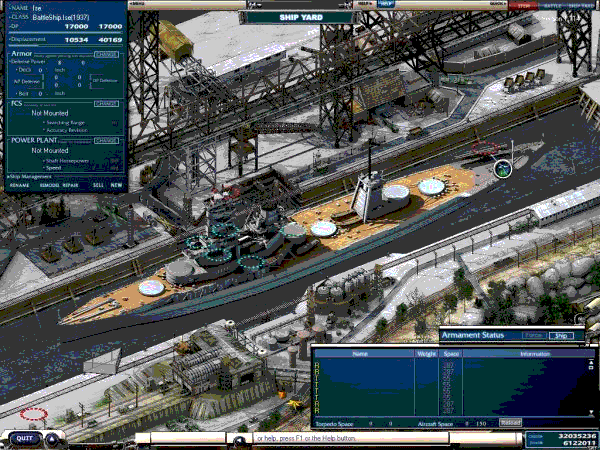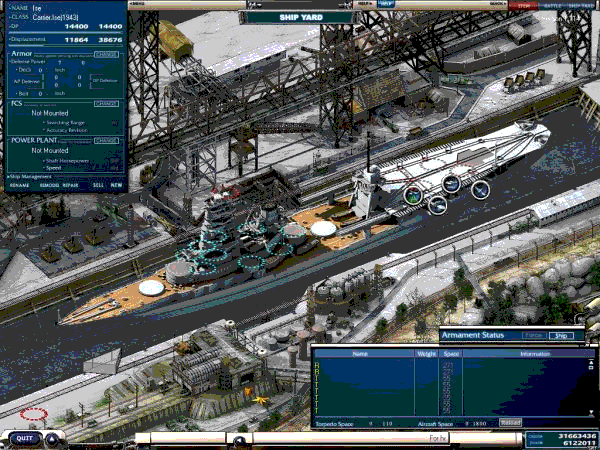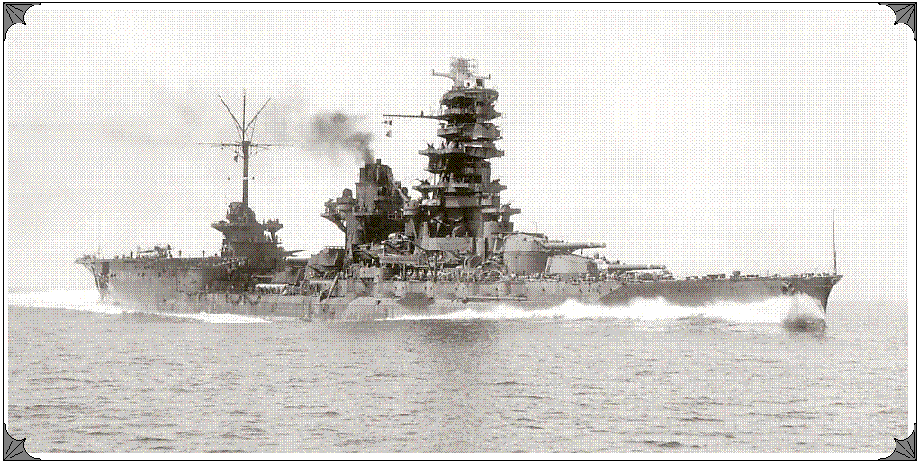
Imperial Japanese Navy - ISE class Battleship ==========================================================================

The two Ise-class battleships; Ise and Hyuga were constructed during WWI and are clearly inspired by british battleship-design. They were meant to be the third and fourth ships in the Fuso-class, but delays and improvements in the Fuso-design led to the design beeing altered. Thus a new class was born which had the #3 and #4 main turrets located aft of the funnel. From 1934 til 1937 these ships underwent major reconstruction resulting in the pagoda-style bridge area so caracteristic for IJN BB's. Later in WWII these ships was reconstructed as hybrid battleship/carriers: (BB/CV for short). The end of the Ise and Hyuga's servicelife came when US bombers crippeled these two sisters. They settled in shallow water and thus it was possible to inspect the damage inflicted. The photos from this inspection are quite interesting but a pretty sad sight. Most of the superstructure intergrity is intact, but with horrible wounds.
Ise was laid down at the Kawasaki Heavy Industries shipyard in Kobe in 1915, completed in 1917, and assigned to the Kure Naval District.
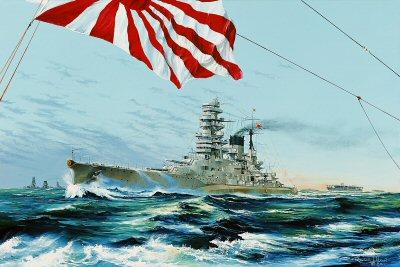
Originally intended as sister ships of the preceding Fuso class, the Ise-class battleships of the Imperial Japanese Navy were considered sufficiently different to warrant separate classification. Designed as modified Fuso class ships, the primary difference between the two were changes to the paired central turrets for an increase in protection and fire control and a slightly longer ship. The Ise also had smaller secondary guns, which in the Japanese preference for offense over defense, were meagerly armored if at all.
Other changes included better splinter protection, more efficient Kampon steam boilers, and the modification of the middle deck to slope down to help protect the sensitive magazines and boiler rooms on the deck beneath it. Like the Fuso, the Ise (and her sistership, Hyuga), were variously modified and reconstructed in the late 1920's and in the mid 1930's. These modifications included the addition of foremast platforms and the installation of smoke hoods over the funnels. The first modifications in 1926 resulted in a flying off platform being added to service three scout aircraft. By the completion of work in 1937, the gun elevation for both ships had been increased which allowed for better range.
Completed too late for service in World War I, in the early 1920s, Ise participated in numerous patrols off the Siberia coast and in northern waters in support of Japan's Siberian Intervention against the Bolshevik Red Army. From the mid-1920s through the late 1930s, Ise patrolled mostly off of the China coast.
Despite efforts at modernization and upgrading, Ise was still considered obsolete by the start of the Pacific War due to her relatively slow speed, large crew, and high fuel consumption, and never saw combat as a battleship. Ise participated in the attack on Pearl Harbor (albeit on a sortie from Hashirajima as far as the Bonin Islands and pursued but did not catch the American carrier force that had launched the Doolittle Raid in 1942.
In May, Ise had an accident which flooded her No.2 engine room. During repair work, Ise was fitted with one of the first experimental model Type 21 radar sets in the Japanese navy. ISE was the first ship to test the Imperial Japanese Navy's new shipborne radar system, carrying this equipment into the battle of Midway the next month.
The last major change to the Ise ships came after the Battle of Midway, when they were reconstructed into carrier-battleship hybrids.
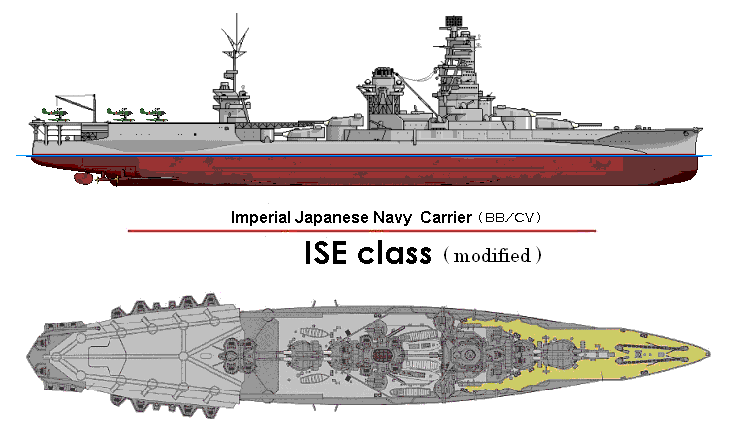
In the middle of World War II some battleships of the Japanese Navy underwent an odd conversion
In the days following the debacle at Midway, the Japanese Navy frantically sought ways to make good their carrier losses. Taking under consideration what was thought to be the growing obsolescence of surface battleships due to their vulnerability to aircraft as seen at Pearl Harbor, and the loss of Force Z. The Imperial Japanese Navy decided to convert several of its surface warships to hybrid Strike Carriers meant to bridge the gap between carriers and surface ships.
The Japanese studied conversion schemes for all ten of their older battleships after Midway. Initially, these were full-scale jobs, involving removing all superstructure, main batteries and heavy/secondary guns then adding a full-length flight deck, island superstructures, offset funnels and AA batteries. Airgroup was estimated at 54.
Originally the naval staff outlined a plan to convert all of the Emperor’s battleships and heavy cruisers to carriers (except for the pair of huge 18" gunned Yamato class behemoths). Proving over-ambitious only the damaged heavy cruiser Mogami and a pair of 25-year old Battleships (Hyuga and Ise) were actually converted.
The Kongo's were ruled out because they were the only big-gun ships fast enough to keep up with the fleet carriers and were needed to act as carrier escorts, and the Nagato's were ruled out because the IJN did not want to lose their 16 inch guns. Eventually surveys showed that rebuilding the remaining four battleships was not viable; the conversions to full scale flat top carriers would take at least two years and would consume more resources than building carriers from scratch.
That left the idea of rebuilding the four 14 inch Fuso and Ise class ships as hybrid semi-carriers. Originally, it was planned to rebuild all four ships (they were very unsatisfactory battleships; the distribution of turrets along the ship's length gave enemies an awful lot of magazines to hit and the 1930s rebuilds had been carried out without proper structural analysis causing excessive stress). Conversion began on the Ise and Hyuga but the planned work on Fuso and Yamashiro was held back pending testing results from the first two ships. However, shipyard congestion meant that only two battleships could be converted, so the Fuso's were also dropped from the program. This left the 14 inch Ise and Hyuga battleships.
The reasons for the selection of the slightly more modern Hyuga's for the conversion were mostly gunnery. The Japanese had increased the elevation of the ship's guns by deepening the gunwells in the turret rather than raising the trunnions. Hull depth aft had prevented this for the aftermost turrets so they had severely restricted elevation, at long range reducing the firepower of the ships by a third. Also, Hyuga had had a turret explosion on 15 May 1942 that had destroyed the X turret - damage that still had not been repaired at the time conversions plans were being considered. Although Ise and Hyuga were slightly faster than their older cousins, the difference was not enough to be really significant.
The two elderly Battleships had spent the first two years of the war almost entirely in Japanese waters. There they had been attached to the Reserve Fleet along with two even older Fuso-class battlewagons forming Battleship Division Two.
The Navy Aircraft Department began plans to convert the two Ise-class battleships to full-sized aircraft carriers. The original conversion was to be a straightforward flattop design that would see the ships stripped of their weapon suite and covered with a flat-top capable of carrying 50-70 conventional aircraft. This concept was abandoned due to lack of time, resources, and above all the aircraft needed to fill them. A hybrid battleship/carrier concept was adopted instead, where the rear portion of the vessel would be modified and the ships amidships and foredeck would remain the same.
There were a lot of competing plans drawn up for the conversions, including some that would have removed four turrets rather than two. In the end, the simplest and least extensive was chosen. Analysis showed that the ships could only use one catapult at a time so any airgroup larger than 24 aircraft could not be efficiently launched.
Ise was dry-docked, and the conversion saw the removal of both aft turrets (weighing 864 tons each) and both barbettes (another 800 tons) which were then replaced with a 70-meter long flight deck that was constructed of 8 inches (200mm) of concrete augmented with armor plating. Also installed was a hangar and a "T"-shaped aircraft elevator. The flight deck was long enough to permit the launch of aircraft, but not their recovery. Plans called for the new hangar to carry nine planes inside, with 11 on deck and two on each catapult; however it was later realized that a single faulty aircraft engine could ruin the whole concept. To prevent jams, the deck was fitted with two rails, 12 turntables, trolleys and tie-downs. Two 25-meter Model 11 catapults were installed on tall supports on the port and starboard sides forward of the flight deck. A collapsible derrick crane was fitted port abaft. The new deck was covered with 200-mm of concrete to compensate for the unbalanced condition created after removal of the aft armament. A one-meter thick layer of concrete was also poured around the main steering and reserve steering rooms and a 150-mm horizontal armor cover was added.
In their book, Layman and McLaughlin claim that the hangar deck/flight deck/catapult assembly weighed much less than the removed gun turrents, leading to a dangerous increase in metacentric height with the resultant danger of very rapid rolling. This, they indicate was the reason why the aircraft deck was covered with an 8 inch layer of concrete, reducing the weight loss to 600 tons.
Some naval historians argue that the concrete was put in there to correct a trim problem - the nearly 2500 tons lost was at the end of the ship's moment arm while the flight deck was weight distributed over a significant proportion of the ship's length. Shifting weights around like this is no small matter - even apparently small changes in weight distribution can have unpleasant and unanticipated side-effects. One guess is that, without the concrete additions, the ship would have trimmed badly by the bows with a very serious impact on speed.
The concrete would also have stiffened the ship aft, replacing some of the structural support lost by removing the barbettes. All four Japanese 14 inch battleships were structurally weak, anyway, so reinforcement would have been no bad thing.
More than one hundred 25mm anti-aircraft guns were also installed, as well as batteries of anti-aircraft rockets. Thus configured, the heavily armored hybrid flat-tops were capable of carrying some 22-24 strike aircraft while still carrying eight large guns and a healthy command and control area. Type 21 air-search radar and two Type 22 surface search radars were also installed.
The modifications to the ships commenced throughout 1943. As modified, Ise could carry 22 aircraft. The operational concept envisioned Ise accompanying the Carrier Strike Force, and launching its 11 Yokosuka D4Y2 Suisei ("Judy") dive-bombers and 11 Aichi E16A Zuiun ("Paul") seaplanes that are capable of diving attacks to add another 44 bombers to the Strike Force. The Suisei had to land either on a conventional carrier or on land bases whereas the E16A could be hoisted back on board after landing near the ship by using a crane. Ise's final aircraft allowance called for 14 E16A and eight D4Y2.
A new type of fast seaplane, capable of both scouting and attack, was also to be designed for these ships. Work on the seaplane, the "Norm", went forward but very few were built.
Neither Ise or Hyuga ever operated aircraft apart from some limited testing. There were never enough aircraft to equip the ships and there was also a shortage of trained pilots. Without the planes and trained crews to fly them the pair subsequently were pressed into service escorting convoys to and from embattled Truk and Singapore in 1943 and 1944 with no embarked air wing.
In their only sortie in this configuration, both the Ise and Hyuga fought in the Battle off Cape Engaño with Ozawa's decoy "Northern Force" in October 1944 as part of the naval campaign in the Leyete Gulf. As a testament to the low numbers of aircraft available to the Japanese Navy the four traditional carriers had a total of 108 aircraft embarked during this battle but the two hybrid-battleship carriers had no aircraft at all on board. . Facing the Japanese task force were no less than 10 US carriers, six modern battleships and more than 600 aircraft. Almost all of the carriers in this group were sunk but both Ise and Hyuga sustained only minor damage.
Escaping with minor damage while most of the Japanese force went to the bottom the two Japanese battleships searched for but narrowly missed engaging US Rear Admiral DuBose's small force of destroyers and cruisers which they had a distinct advantage over. Had they encountered DuBose they would have written a much more interesting chapter in their history.
After returning to home waters, both ships had their catapults removed. This was done to improve the arcs of fire for the center turrets. Re-designated as a 4th class reserve ship, Ise was towed to Ondo Seto (between Kure and Kurahashijima) to serve as a floating anti-aircraft battery.
The IJN was now totally on the defensive and the concept of operating seaplanes on Ise and Hyuga was abandoned. Both ships remained anchored in home waters for the remainder of the war. Both of the Ise class battleships were sunk in shallow water at Kure Harbor with less than a month remaining in the war.
The two ships ended their careers in waves of US aircraft carrier strikes. Neither of the Japanese battleships hybrids had ever seen combats in their new role as aircraft carriers. The Ise sat camouflaged in Kure harbor as one of the highly endangered species that was a still-intact Japanese warship. The ships endured massive attacks from US carrier planes from March to July. The Hyuga's crew ran her hard aground in Niro Bay where she was finally sunk on 24 July 1945 by air strikes from US Navy carrier planes, and the Ise was sunk four days later after taking sixteen bomb hits, then finally listing and settling on the bottom of Kure harbor on July 28, 1945. Both ships were sunk just over two weeks before Emperor Hirohito gave a recorded radio address to the nation calling for surrender. Both ships were broken up over the course of the next two years and scrapped.
Epilogue
Twenty years later the Soviet Russian navy built, as their first operational aircraft carriers, the Moskva and Kiev classes of hybrid cruiser-carriers which greatly resemble the japanese concept of the modified Ise class ships. There was also an abortive US effort in the 1970s involving the proposed conversion of the mothballed USS Iowa class battleships which was canceled by the Carter administration.
The Hyuga's name was recycled in 2009 for a new Japanese warship. Fittingly, the new Japanese Self Defense Force ship JS Hyuga is a 18,000 ton hybrid-aircraft carrier and is currently Japan's largest surface warship afloat. It remains to be seen if her sister ship currently under construction will be named Ise.
=================================================================================
NB: The above text has been collected / excerpted / edited / mangled / tangled / re-compiled / etc ... from the following online sources :
IJN - Ise Class Battleship - wikipedia article #1
IJN - Ise Class Battleship - wikipedia article #2
IJN - Ise Class Battleship - www.globalsecurity.org
IJN - Ise Class Battleship - www.bismarck-class.dk
IJN - Ise Class Battleship - smmlonline.com
IJN - Ise Class Battleship - www.navweaps.com
IJN - Ise Class Battleship - www.combinedfleet.com
IJN - Ise Class Battleship - aeronautic.dk
IJN - Ise Class Battleship - www.nationmaster.com
IJN - Ise Class Battleship - www.onwar.com
IJN - Ise Class Battleship - www.lostbattalion.com
IJN - Ise Class Battleship - www.absoluteastronomy.com
IJN - Japanese Hybrid Battleship-Carriers - www.navweaps.com
IJN - Hybrid BattleCarriers of Japan - ww2history.suite101.com/
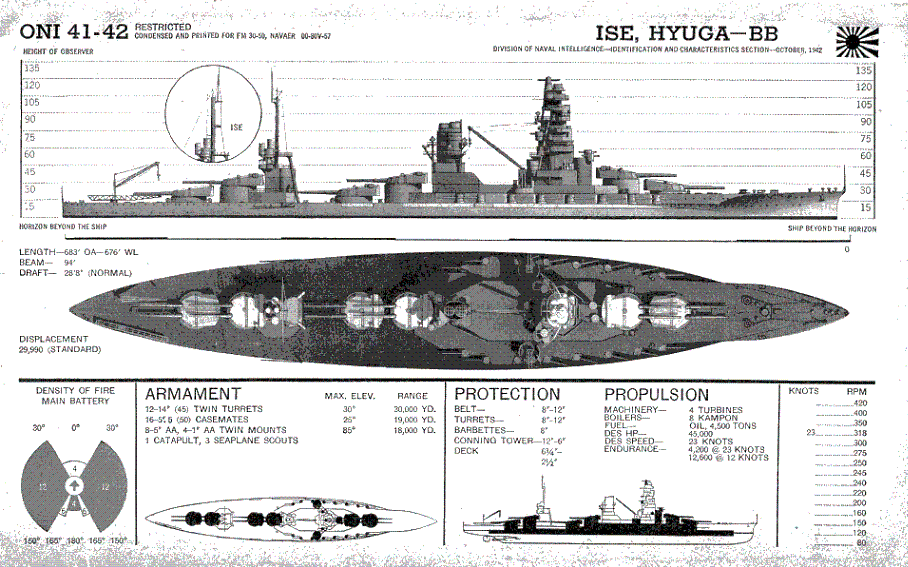

The sword from the dragon's tail, the Ama-no-Murakumo-no-Tsurugi or "Sword of the Gathering Clouds of Heaven", (also known as the Kusanagi-no-Tsurugi or "Grasscutter Sword"), was presented by Susanoo (god of sea and storm) to Amaterasu (goddess of the sun) as a reconciliation gift. According to legends, she then later bequeathed it to her descendant Ninigi-no-Mikoto along with the Yata-no-Kagami mirror and Yasakani-no-Magatama jewel or orb. This sacred sword, mirror, and jewel collectively became the three Imperial Regalia of Japan.
Generations later, in the reign of the Twelfth Emperor, Keiko, the sword was given to the great warrior, Yamato Takeru as part of a pair of gifts given by his aunt, Yamato-hime the Shrine Maiden of Ise Shrine (the most venerable shrine in the whole of Japan), to protect her nephew in times of peril.



